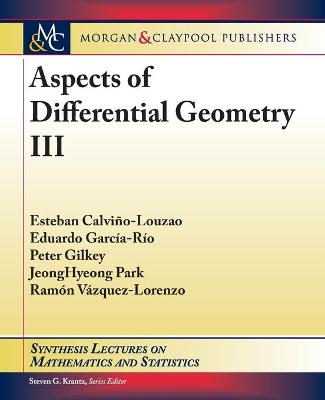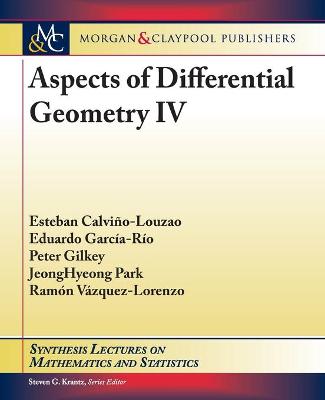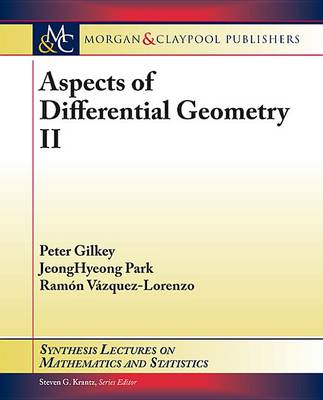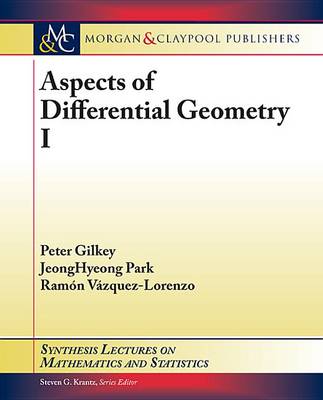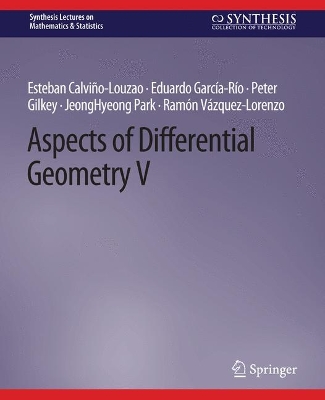Synthesis Lectures on Mathematics and Statistics
7 total works
The Geometry of Walker Manifolds
by Peter Gilkey, Miguel Brozos-vazquez, Eduardo Garcia-Rio, and Stana Nikčevic
Published 1 June 2009
This book, which focuses on the study of curvature, is an introduction to various aspects of pseudo- Riemannian geometry. We shall use Walker manifolds (pseudo-Riemannian manifolds which admit a non-trivial parallel null plane field) to exemplify some of the main differences between the geometry of Riemannian manifolds and the geometry of pseudo-Riemannian manifolds and thereby illustrate phenomena in pseudo-Riemannian geometry that are quite different from those which occur in Riemannian geometry, i.e. for indefinite as opposed to positive definite metrics. Indefinite metrics are important in many diverse physical contexts: classical cosmological models (general relativity) and string theory to name but two. Walker manifolds appear naturally in numerous physical settings and provide examples of extremal mathematical situations as will be discussed presently. To describe the geometry of a pseudo-Riemannian manifold, one must first understand the curvature of the manifold. We shall analyze a wide variety of curvature properties and we shall derive both geometrical and topological results. Special attention will be paid to manifolds of dimension 3 as these are quite tractable. We then pass to the 4 dimensional setting as a gateway to higher dimensions. Since the book is aimed at a very general audience (and in particular to an advanced undergraduate or to a beginning graduate student), no more than a basic course in differential geometry is required in the way of background. To keep our treatment as self-contained as possible,we shall begin with two elementary chapters that provide an introduction to basic aspects of pseudo-Riemannian geometry before beginning on our study of Walker geometry. An extensive bibliography is provided for further reading.
Aspects of Differential Geometry III
by Esteban Calvino-Louzao, Eduardo Garcia-Rio, Peter Gilkey, Jeonghyeong Park, and Ramon Vazquez-Lorenzo
Published 25 May 2017
Differential Geometry is a wide field. We have chosen to concentrate upon certain aspects that are appropriate for an introduction to the subject; we have not attempted an encyclopedic treatment.
Book III is aimed at the first-year graduate level but is certainly accessible to advanced undergraduates. It deals with invariance theory and discusses invariants both of Weyl and not of Weyl type; the Chern‒Gauss‒Bonnet formula is treated from this point of view. Homothety homogeneity, local homogeneity, stability theorems, and Walker geometry are discussed. Ricci solitons are presented in the contexts of Riemannian, Lorentzian, and affine geometry.
Book III is aimed at the first-year graduate level but is certainly accessible to advanced undergraduates. It deals with invariance theory and discusses invariants both of Weyl and not of Weyl type; the Chern‒Gauss‒Bonnet formula is treated from this point of view. Homothety homogeneity, local homogeneity, stability theorems, and Walker geometry are discussed. Ricci solitons are presented in the contexts of Riemannian, Lorentzian, and affine geometry.
Aspects of Differential Geometry IV
by Esteban Calvino-Louzao, Eduardo Garcia-Rio, Peter Gilkey, Jeonghyeong Park, and Ramon Vazquez-Lorenzo
Published 18 April 2019
Book IV continues the discussion begun in the first three volumes.
Although it is aimed at first-year graduate students, it is also intended to serve as a basic reference for people working in affine differential geometry. It also should be accessible to undergraduates interested in affine differential geometry. We are primarily concerned with the study of affine surfaces which are locally homogeneous. We discuss affine gradient Ricci solitons, affine Killing vector fields, and geodesic completeness. Opozda has classified the affine surface geometries which are locally homogeneous; we follow her classification. Up to isomorphism, there are two simply connected Lie groups of dimension 2. The translation group ℝ² is Abelian and the ???? + ?? group is non-Abelian. The first chapter presents foundational material. The second chapter deals with Type ?? surfaces. These are the left-invariant affine geometries on ℝ². Associating to each Type ?? surface the space of solutions to the quasi-Einstein equation corresponding to the eigenvalue ?? = -1 turns out to be a very powerful technique and plays a central role in our study as it links an analytic invariant with the underlying geometry of the surface. The third chapter deals with Type ?? surfaces; these are the left-invariant affine geometries on the ???? + ?? group. These geometries form a very rich family which is only partially understood. The only remaining homogeneous geometry is that of the sphere ??². The fourth chapter presents relations between the geometry of an affine surface and the geometry of the cotangent bundle equipped with the neutral signature metric of the modified Riemannian extension.
Although it is aimed at first-year graduate students, it is also intended to serve as a basic reference for people working in affine differential geometry. It also should be accessible to undergraduates interested in affine differential geometry. We are primarily concerned with the study of affine surfaces which are locally homogeneous. We discuss affine gradient Ricci solitons, affine Killing vector fields, and geodesic completeness. Opozda has classified the affine surface geometries which are locally homogeneous; we follow her classification. Up to isomorphism, there are two simply connected Lie groups of dimension 2. The translation group ℝ² is Abelian and the ???? + ?? group is non-Abelian. The first chapter presents foundational material. The second chapter deals with Type ?? surfaces. These are the left-invariant affine geometries on ℝ². Associating to each Type ?? surface the space of solutions to the quasi-Einstein equation corresponding to the eigenvalue ?? = -1 turns out to be a very powerful technique and plays a central role in our study as it links an analytic invariant with the underlying geometry of the surface. The third chapter deals with Type ?? surfaces; these are the left-invariant affine geometries on the ???? + ?? group. These geometries form a very rich family which is only partially understood. The only remaining homogeneous geometry is that of the sphere ??². The fourth chapter presents relations between the geometry of an affine surface and the geometry of the cotangent bundle equipped with the neutral signature metric of the modified Riemannian extension.
Differential Geometry is a wide field. We have chosen to concentrate upon certain aspects that are appropriate for an introduction to the subject; we have not attempted an encyclopedic treatment.
Book II deals with more advanced material than Book I and is aimed at the graduate level. Chapter 4 deals with additional topics in Riemannian geometry. Properties of real analytic curves given by a single ODE and of surfaces given by a pair of ODEs are studied, and the volume of geodesic balls is treated. An introduction to both holomorphic and Kahler geometry is given. In Chapter 5, the basic properties of de Rham cohomology are discussed, the Hodge Decomposition Theorem, Poincare duality, and the Kunneth formula are proved, and a brief introduction to the theory of characteristic classes is given. In Chapter 6, Lie groups and Lie algebras are dealt with. The exponential map, the classical groups, and geodesics in the context of a bi-invariant metric are discussed. The de Rham cohomology of compact Lie groups and the Peter--Weyl Theorem are treated. In Chapter 7, material concerning homogeneous spaces and symmetric spaces is presented. Book II concludes in Chapter 8 where the relationship between simplicial cohomology, singular cohomology, sheaf cohomology, and de Rham cohomology is established.
We have given some different proofs than those that are classically given and there is some new material in these volumes. For example, the treatment of the total curvature and length of curves given by a single ODE is new as is the discussion of the total Gaussian curvature of a surface defined by a pair of ODEs.
Book II deals with more advanced material than Book I and is aimed at the graduate level. Chapter 4 deals with additional topics in Riemannian geometry. Properties of real analytic curves given by a single ODE and of surfaces given by a pair of ODEs are studied, and the volume of geodesic balls is treated. An introduction to both holomorphic and Kahler geometry is given. In Chapter 5, the basic properties of de Rham cohomology are discussed, the Hodge Decomposition Theorem, Poincare duality, and the Kunneth formula are proved, and a brief introduction to the theory of characteristic classes is given. In Chapter 6, Lie groups and Lie algebras are dealt with. The exponential map, the classical groups, and geodesics in the context of a bi-invariant metric are discussed. The de Rham cohomology of compact Lie groups and the Peter--Weyl Theorem are treated. In Chapter 7, material concerning homogeneous spaces and symmetric spaces is presented. Book II concludes in Chapter 8 where the relationship between simplicial cohomology, singular cohomology, sheaf cohomology, and de Rham cohomology is established.
We have given some different proofs than those that are classically given and there is some new material in these volumes. For example, the treatment of the total curvature and length of curves given by a single ODE is new as is the discussion of the total Gaussian curvature of a surface defined by a pair of ODEs.
Aspects of Differential Geometry I
by Peter Gilkey, Jeonghyeong Park, and Ramon Vazquez-Lorenzo
Published 1 February 2015
Differential Geometry is a wide field. We have chosen to concentrate upon certain aspects that are appropriate for an introduction to the subject; we have not attempted an encyclopedic treatment. In Book I, we focus on preliminaries. Chapter 1 provides an introduction to multivariable calculus and treats the Inverse Function Theorem, Implicit Function Theorem, the theory of the Riemann Integral, and the Change of Variable Theorem. Chapter 2 treats smooth manifolds, the tangent and cotangent bundles, and Stokes' Theorem. Chapter 3 is an introduction to Riemannian geometry. The Levi-Civita connection is presented, geodesics introduced, the Jacobi operator is discussed, and the Gauss-Bonnet Theorem is proved. The material is appropriate for an undergraduate course in the subject. We have given some different proofs than those that are classically given and there is some new material in these volumes. For example, the treatment of the Chern-Gauss-Bonnet Theorem for pseudo-Riemannian manifolds with boundary is new.
Applications of Affine and Weyl Geometry
by Eduardo Garcia-Rio, Peter Gilkey, Stana Nik?evi?, and Ramon Vazquez-Lorenzo
Published 1 May 2013
Pseudo-Riemannian geometry is, to a large extent, the study of the Levi-Civita connection, which is the unique torsion-free connection compatible with the metric structure. There are, however, other affine connections which arise in different contexts, such as conformal geometry, contact structures, Weyl structures, and almost Hermitian geometry. In this book, we reverse this point of view and instead associate an auxiliary pseudo-Riemannian structure of neutral signature to certain affine connections and use this correspondence to study both geometries. We examine Walker structures, Riemannian extensions, and Kahler--Weyl geometry from this viewpoint. This book is intended to be accessible to mathematicians who are not expert in the subject and to students with a basic grounding in differential geometry. Consequently, the first chapter contains a comprehensive introduction to the basic results and definitions we shall need-proofs are included of many of these results to make it as self-contained as possible. Para-complex geometry plays an important role throughout the book and consequently is treated carefully in various chapters, as is the representation theory underlying various results. It is a feature of this book that, rather than as regarding para-complex geometry as an adjunct to complex geometry, instead, we shall often introduce the para-complex concepts first and only later pass to the complex setting.
The second and third chapters are devoted to the study of various kinds of Riemannian extensions that associate to an affine structure on a manifold a corresponding metric of neutral signature on its cotangent bundle. These play a role in various questions involving the spectral geometry of the curvature operator and homogeneous connections on surfaces. The fourth chapter deals with Kahler--Weyl geometry, which lies, in a certain sense, midway between affine geometry and Kahler geometry. Another feature of the book is that we have tried wherever possible to find the original references in the subject for possible historical interest. Thus, we have cited the seminal papers of Levi-Civita, Ricci, Schouten, and Weyl, to name but a few exemplars. We have also given different proofs of various results than those that are given in the literature, to take advantage of the unified treatment of the area given herein.
The second and third chapters are devoted to the study of various kinds of Riemannian extensions that associate to an affine structure on a manifold a corresponding metric of neutral signature on its cotangent bundle. These play a role in various questions involving the spectral geometry of the curvature operator and homogeneous connections on surfaces. The fourth chapter deals with Kahler--Weyl geometry, which lies, in a certain sense, midway between affine geometry and Kahler geometry. Another feature of the book is that we have tried wherever possible to find the original references in the subject for possible historical interest. Thus, we have cited the seminal papers of Levi-Civita, Ricci, Schouten, and Weyl, to name but a few exemplars. We have also given different proofs of various results than those that are given in the literature, to take advantage of the unified treatment of the area given herein.
Aspects of Differential Geometry V
by Esteban Calviño-Louzao, Eduardo García-Río, Peter Gilkey, Jeonghyeong Park, and Ramón Vázquez-Lorenzo
Published 6 April 2021
Book V completes the discussion of the first four books by treating in some detail the analytic results in elliptic operator theory used previously. Chapters 16 and 17 provide a treatment of the techniques in Hilbert space, the Fourier transform, and elliptic operator theory necessary to establish the spectral decomposition theorem of a self-adjoint operator of Laplace type and to prove the Hodge Decomposition Theorem that was stated without proof in Book II. In Chapter 18, we treat the de Rham complex and the Dolbeault complex, and discuss spinors. In Chapter 19, we discuss complex geometry and establish the Kodaira Embedding Theorem.

